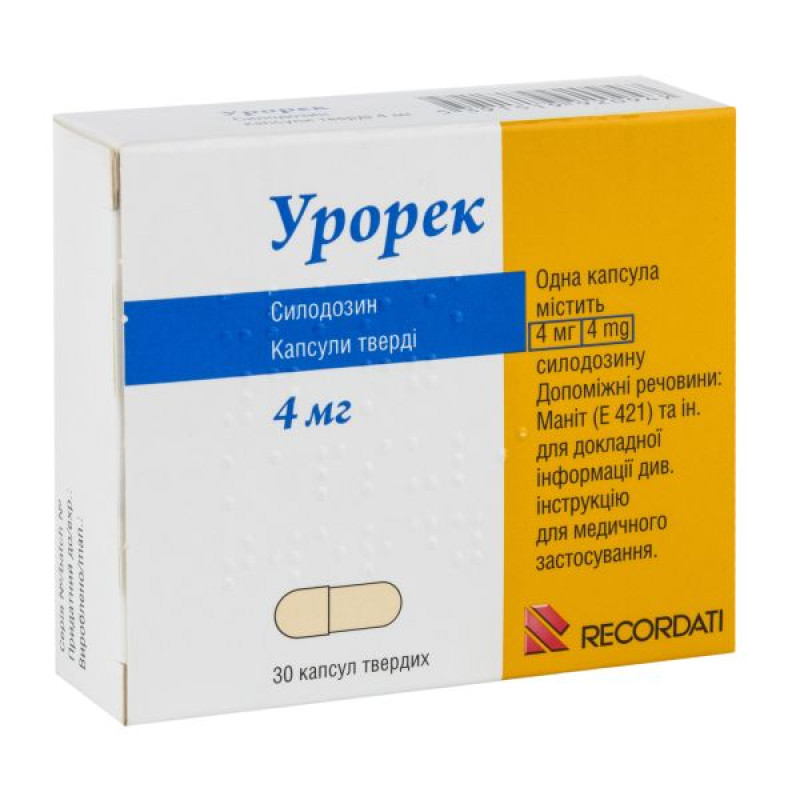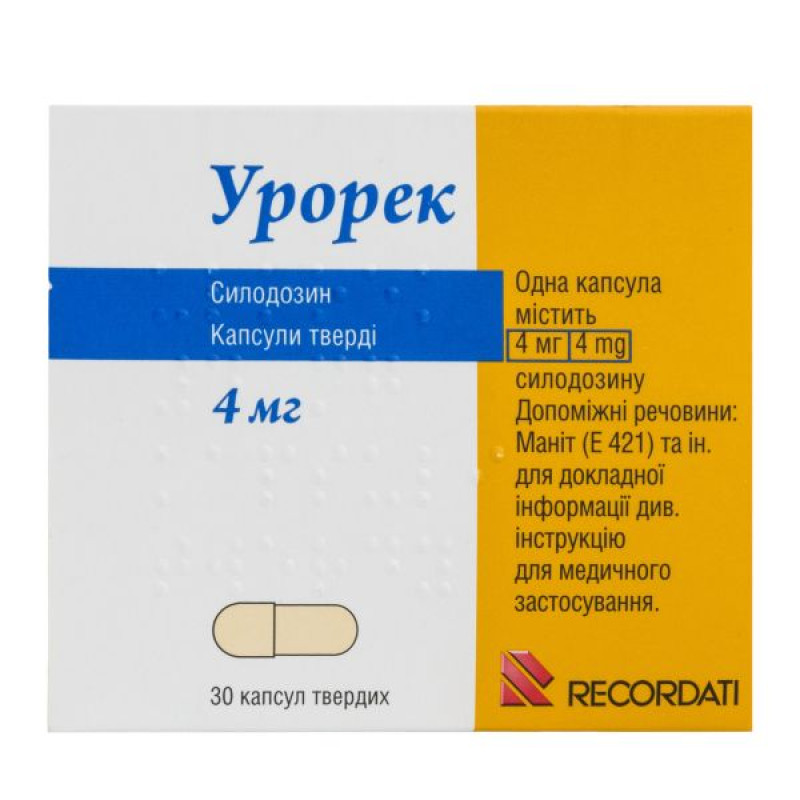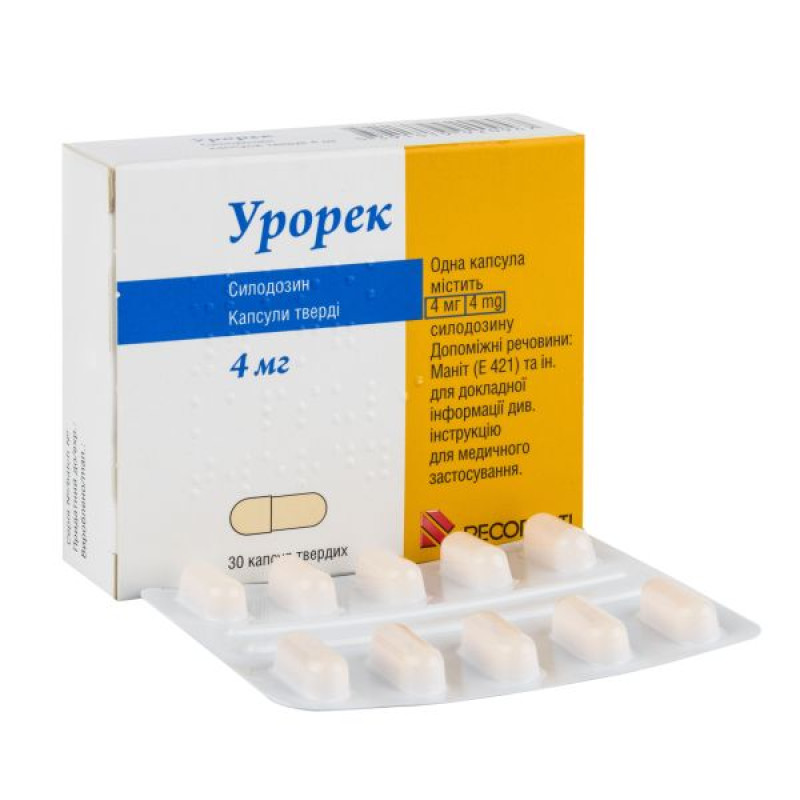Urorek hard capsules 4 mg blister No. 30

Instructions for Urorek hard capsules 4 mg blister No. 30
Composition
active ingredient: 1 capsule contains 4 mg or 8 mg of silodosin;
excipients: mannitol (E 421), peptized corn starch, purified water, sodium lauryl sulfate, magnesium stearate, gelatin, titanium dioxide (E 171), for a dosage of 4 mg, iron oxide yellow (E 172).
Dosage form
The capsules are hard.
Main physicochemical properties:
hard capsules containing 4 mg silodosin,
Hard capsules containing 8 mg of silodosin.
Pharmacotherapeutic group
α-Adrenoceptor antagonists. Silodosin.
ATX code G04C A04.
Pharmacological properties
Pharmacodynamics.
Silodosin is a highly selective α1A-adrenergic receptor antagonist, which is found mainly in the prostate gland, at the bottom of the bladder, in the bladder neck, in the prostate capsule and the prostatic part of the urethra. Blockade of these α1A-adrenergic receptors provides relaxation of the smooth muscles of this department, which, in turn, increases the rate of urine outflow without affecting the contractility of the detrusor smooth muscle. As a result, the symptoms of irritation and obstruction caused by benign prostatic hyperplasia (BPH) disappear.
Silodosin has a much lower affinity for α1B-adrenoceptors, which are localized mainly in the tissues of the cardiovascular system.
In vitro studies have shown that the ability of silodosin to bind to α1A and α1B adrenoceptors is related as 162:1.
It is well established that improvement in American Urological Association (AUA) symptoms is significantly greater with silodosin 4 mg or 8 mg than with placebo. Clinical trials conducted in the United States and Europe with silodosin 8 mg once daily have demonstrated significant improvements in both storage (irritation) and discharge (obstruction) symptoms of BPH compared with placebo, as assessed by the International Prostate Symptom Score (IPSS) after 12 weeks of treatment. In clinical trials conducted in Europe, silodosin 8 mg once daily was non-inferior to tamsulosin 0.4 mg once daily. The response rate, i.e. improvement in the overall IPSS score, was significantly higher in the silodosin and tamsulosin groups compared with placebo.
In the long-term open-label extension phase of these clinical trials, in which patients received silodosin for up to 1 year, the improvement in symptoms with silodosin at week 12 of treatment was maintained for more than 1 year.
In a phase IV clinical trial conducted in Europe, 77.1% of patients responded to treatment as assessed by the International Prostatic Symptom Score. Approximately half of patients with the most bothersome symptoms, namely nocturia, increased urinary frequency, weak stream, urgency, dribbling at the end of urination and incomplete bladder emptying, reported improvement as measured by the International Continence Society (ICS) Male Incontinence Questionnaire.
In all clinical studies conducted with silodosin, no significant decrease in blood pressure was observed in the patient in the horizontal position.
Silodosin at doses of 8 mg and 24 mg per day compared to placebo had no statistically significant effect on ECG intervals or cardiac repolarization.
Pharmacokinetics.
The pharmacokinetics of silodosin and its major metabolites have been evaluated in adult male patients, healthy or with BPH, after single and/or multiple doses of 0.1 mg to 48 mg/day. The pharmacokinetics of silodosin are linear over this dose range.
The exposure of the major metabolite, silodosin glucuronide (KMD-3213G), in plasma at steady state is 3-fold higher than that of the parent drug. Silodosin and its glucuronide reach steady state after 3 days and 5 days of treatment, respectively.
Absorption.
Silodosin is well absorbed after oral administration, with absorption being proportional to the administered dose. The absolute bioavailability of the drug is approximately 32%.
An in vitro study with Caco-2 cells showed that silodosin is a substrate for P-glycoprotein.
When the drug is taken with food, the Cmax value decreases by approximately 30%, tmax increases by approximately 1 hour, and no change in AUC is observed. After oral administration of 8 mg of the drug once daily immediately after breakfast for 7 days, the following pharmacokinetic parameters were determined: Cmax – 87 ± 51 ng/ml (SD), tmax – 2.5 hours (range 1.0-3.0), AUC – 433 ± 286 ng/h/ml.
Distribution.
The volume of distribution of silodosin is 0.81 l/kg. Silodosin is 96.6% bound to plasma proteins. It does not distribute into blood cells.
Protein binding of silodosin glucuronide is 91%.
Silodosin is metabolized by glucuronidation (UGT2B7), alcohol and aldehyde dehydrogenase, and oxidation, mainly by CYP3A4. The main metabolite in plasma, the conjugated glucuronide of silodosin (KMD-3213G), which has been shown to be active in vitro, has a longer half-life (approximately 24 hours) and is approximately 4 times more concentrated in plasma than silodosin itself. In vitro data indicate that silodosin does not inhibit or potentiate cytochrome P450 isoenzymes.
Breeding.
After oral administration of silodosin, approximately 33.5% is excreted in the urine and 54.9% in the feces after 7 days. The total clearance of silodosin is approximately 0.28 l/h/kg. Silodosin is excreted mainly as metabolites, with only a very small percentage of the drug excreted unchanged in the urine. The terminal half-lives of the unchanged drug and its glucuronides are approximately 11 hours and 18 hours, respectively.
Pharmacokinetics in special patient groups.
Elderly patients.
The exposure characteristics of silodosin and its major metabolites are independent of patient age. The total clearance of silodosin remains unchanged even in patients over 75 years of age.
Children.
The effects of silodosin have not been evaluated in patients under 18 years of age.
Liver dysfunction.
The pharmacokinetics of silodosin are similar in patients with moderate hepatic impairment (Child-Pugh score 7-9) and healthy volunteers. The results of this study should be interpreted with caution because the patients had normal biochemical parameters, indicating normal metabolic function, and were classified as patients with moderate hepatic impairment due to ascites and hepatic encephalopathy. The pharmacokinetics of silodosin in patients with severe hepatic impairment have not been studied.
Kidney dysfunction.
A single-dose study showed that Cmax and AUC of silodosin (unbound) were increased by 1.6-fold and 1.7-fold, respectively, in patients with mild to moderate renal impairment compared to patients with normal renal function. In patients with severe renal impairment, Cmax was increased by 2.2-fold and AUC by 3.7-fold. The pharmacokinetics of the major metabolites of the drug, silodosin glucuronide and KMD3293, were also increased.
The concentration of silodosin in the blood plasma after 4 weeks of administration in patients with moderate renal impairment is the same as in patients with normally functioning kidneys, and in patients with moderate renal impairment the concentration of the drug increases by twofold.
A review of all safety data suggests that silodosin therapy in patients with moderate renal impairment is not associated with an increased risk of dizziness or orthostatic hypotension compared to patients with normal renal function. Therefore, no dose adjustment is required for patients with moderate renal impairment. Due to limited data on the results of taking the drug in patients with moderate renal impairment, the recommended starting dose is 4 mg. Silodosin is not recommended for use in patients with severe renal impairment.
Indication
Symptomatic treatment of benign prostatic hyperplasia (BPH).
Contraindication
Hypersensitivity to silodosin or any of the excipients in the drug.
Interaction with other medicinal products and other types of interactions
Silodosin is extensively metabolized, particularly by CYP3A4, alcohol dehydrogenase, and UGT2B7. Silodosin is also a substrate for P-glycoprotein. Substances that inhibit or induce these enzymes and transporters may affect the plasma concentrations of silodosin and its active metabolites.
α-blockers.
There is no adequate information on the safety of silodosin in concomitant therapy with α-adrenergic receptor antagonists. Therefore, concomitant use with other α-adrenergic receptor antagonists is not recommended (see section 4.4).
Inhibitors of CYP3A4 isoenzymes.
A drug interaction study has shown that when co-administered with a potent CYP3A4 inhibitor (ketoconazole, 400 mg), the maximum plasma concentration of silodosin increases by 3.7-fold and the exposure to silodosin (AUC value) increases by 3.1-fold. Co-administration with potent CYP3A4 inhibitors (such as ketoconazole, itraconazole or ritonavir) is not recommended.
When silodosin was co-administered with moderate CYP3A4 inhibitors, such as diltiazem, an increase in AUC of approximately 30% was observed, but Cmax and half-life remained unchanged. This change is not clinically significant and therefore no dose adjustment is required.
With the simultaneous use of sildenafil at a dose of 100 mg or tadalafil at a dose of 20 mg, a minimal pharmacodynamic interaction was observed, which did not cause a clinically significant significant decrease in systolic or diastolic blood pressure according to the results of the orthostatic test (in the upright position versus the horizontal position). In patients over 65 years of age, the average decrease at different time points was between 5 and 15 mm Hg (systolic) and 0 and 10 mm Hg (diastolic). During the simultaneous use of the drugs, positive orthostatic tests were not significantly more frequent; however, there were no cases of symptomatic orthostatic hypotension or dizziness. Patients taking Urorec concomitantly with PDE-5 inhibitors should be monitored to avoid possible adverse reactions.
Antihypertensive drugs.
In the clinical trial program, many patients received concomitant antihypertensive therapy (mostly agents that affect the renin-angiotensin system, beta-blockers, calcium antagonists, and diuretics) without an increased risk of orthostatic hypotension. However, caution should be exercised when initiating concomitant antihypertensive therapy; patients should be monitored for adverse events.
Digoxin.
When co-administered with silodosin 8 mg once daily, the steady-state concentration of digoxin, a P-glycoprotein substrate, was not significantly altered. No dose adjustment is required.
Application features
Intraoperative floppy iris syndrome.
Intraoperative floppy iris syndrome (a variant of sluggish pupillary reaction syndrome) has been observed during cataract surgery in some patients receiving or previously receiving α1-blockers. This complication may increase the risk of procedural complications during surgery.
Patients are not recommended to start treatment with Urorec before elective cataract surgery. It is recommended to stop α1-blocker therapy 1-2 weeks before cataract surgery, but the duration of stopping therapy before cataract surgery and the benefits of this have not yet been established.
During the period of preparation for cataract surgery, surgeons and ophthalmologists should find out whether the patient is taking or has previously taken Urorec, in order to take appropriate measures to avoid intraoperative flaccid iris syndrome during surgery.
Orthostatic phenomena.
Orthostatic phenomena during treatment with Urorec occur very rarely. However, in some patients, a decrease in blood pressure may occur, which in some cases can lead to loss of consciousness. At the first signs of orthostatic hypotension (for example, in the case of orthostatic dizziness), the patient should be seated or laid down until the symptoms disappear. Therapy with Urorec is not recommended for patients suffering from orthostatic hypotension.
Kidney dysfunction.
The use of Urorec for the treatment of patients with severe renal impairment (CLCR <30 ml/min) is not recommended.
Liver dysfunction.
The use of Urorec for the treatment of patients with severe hepatic impairment is not recommended, as there is no necessary information.
Prostate carcinoma.
Since BPH and prostate carcinoma have similar symptoms and both diseases can occur simultaneously, prostate carcinoma should be excluded before prescribing Urorec for BPH. A digital rectal examination should be performed. Prostate-specific antigen (PSA) should also be measured before starting treatment and at regular intervals thereafter, if necessary.
Reproductive ability.
Treatment with Urorec results in a reduction in ejaculation during orgasm and may temporarily affect male fertility. Retrograde ejaculation (orgasm with limited or no ejaculation) has been reported in patients taking silodosin. This effect resolves after discontinuation of Urorec.
Before starting therapy, the patient should be informed about the possibility of retrograde ejaculation.
Use during pregnancy or breastfeeding
Silodosin is intended for the treatment of male patients only.
Ability to influence reaction speed when driving vehicles or other mechanisms
Specialized studies to determine the effect of the drug on the ability to drive vehicles and other machinery have not been conducted. Patients should be warned about the possibility of phenomena caused by orthostatic hypotension (such as dizziness) and should be warned against driving a car or operating machinery until they know how Urorec affects their condition.
Method of administration and doses
The drug should be taken with food, preferably at the same time of day. The capsule should not be broken, it should be swallowed whole, without chewing, with a glass of water.
Elderly patients.
No dose adjustment is required for elderly patients (see section "Pharmacokinetics").
Patients with renal impairment.
No dose adjustment is required for patients with moderate renal impairment (CLCR ≥50 to <80 mL/min). In cases of moderate renal impairment (CLCR ≥30 to <50 mL/min), therapy should be initiated with a dose of 4 mg silodosin once daily, and then, based on individual response, the dose may be increased to 8 mg once daily after 1 week of treatment. The drug is not recommended for use in patients with severe renal impairment (CLCR <30 mL/min).
Patients with impaired liver function.
No dose adjustment is required for patients with mild or moderate hepatic impairment. Since there is no clinical experience in patients with severe hepatic impairment, the use of the drug in this category of patients is not recommended.
Children: Do not use in pediatric practice.
Overdose
Silodosin has been evaluated at doses up to 48 mg/day in healthy male volunteers. The dose-limiting adverse reaction was orthostatic hypotension.
If the drug intake has occurred recently, it is recommended to induce vomiting or perform gastric lavage. If an overdose of Urorec is accompanied by hypotension, it is necessary to provide the patient with cardiovascular support. Dialysis is not advisable, since silodosin in the body is almost completely bound to blood proteins (96.6%).
Side effects
The most common adverse reactions reported during silodosin therapy in placebo-controlled clinical trials and during long-term use were ejaculation disorders, such as retrograde ejaculation and anejaculation (reduced or absent ejaculation), with an incidence of 23%. This may temporarily affect male fertility. However, it returns within a few days after discontinuation of treatment.
The table below lists the adverse reactions reported during all clinical trials and during post-marketing use of the drug, according to MedDRA system organ class and frequency: very common (≥1/10); common (≥1/100 to <1/10); uncommon (≥1/1000 to <1/100); rare (<1/10000) and unknown frequency (in cases where the frequency of the reaction cannot be estimated from the available data). Within each group, the reactions are listed in order of decreasing seriousness.
| Organ system | Very common | Frequent | Infrequent | Single | Rare | Frequency not set |
| On the part of the immune system | Allergic-type reactions including facial swelling, tongue swelling and pharyngeal edema1 | |||||
| Mental disorders | Decreased libido | |||||
| From the nervous system | Dizziness | Loss of consciousness1 | Faint | |||
| From the heart | Tachycardia1 | Palpitations1 | ||||
| From the vascular system | Orthostatic hypotension | Hypotension1 | ||||
| Respiratory, thoracic and mediastinal disorders | Nasal congestion | |||||
Gastrointestinal tract tract tract | Diarrhea | Nausea, dry mouth | ||||
| Liver and biliary tract disorders | Abnormal liver function tests1 | |||||
| Skin and subcutaneous tissue disorders | Skin rash1, pruritus1, urticaria1, drug eruption1 | |||||
| From the reproductive system and mammary glands | Retrograde ejaculation, anejaculation | Erectile dysfunction | ||||
| Injuries, poisonings, procedural complications | Intraoperative floppy iris syndrome |
1 – data on adverse reactions obtained from spontaneous reports during post-marketing use worldwide (frequency calculated taking into account cases reported in phase I-IV clinical trials and non-interventional studies).
Orthostatic hypotension: The incidence of orthostatic hypotension in placebo-controlled clinical trials was 1.2% with silodosin and 1.0% with placebo. Orthostatic hypotension may cause syncope (see section 4.4).
Intraoperative floppy iris syndrome (a variant of floppy pupil syndrome) has been observed during cataract surgery (see section "Special warnings and precautions for use").
Expiration date
3 years.
Storage conditions
Store in the original packaging to protect from light and moisture at a temperature not exceeding 30 ° C. Keep out of the reach of children.
Packaging
For 4 mg dosage: 10 capsules in a blister; 1, or 3, or 5, or 9 blisters in a cardboard pack.
For 8 mg dosage: 10 capsules in a blister; 1, or 3, or 5, or 9 blisters in a cardboard pack.
Vacation category
According to the recipe.
Producer
Recordati Industria Chimica e Farmaceutica SpA
Address
Rehins East, Ringeskiddie, Co. Cork, Ireland/
Raheens East, Ringaskiddy, Co. Cork, Ireland.
Applicant
Recordati Ireland Ltd.
There are no reviews for this product.
There are no reviews for this product, be the first to leave your review.
No questions about this product, be the first and ask your question.








